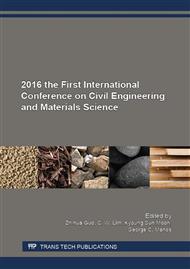[1]
A. M. Neville, Properties of concrete, 4th Edn, Longman group Ltd, Harlow, England. (1996).
Google Scholar
[2]
W. P. S. Dias, G. A. Khoury, P. J. E. Sullivan, Mechanical properties of hardened cement paste exposed to temperatures up to 7000C, ACI Material Journal, 87(2) 160-166.
Google Scholar
[3]
J. Ding, Y. Fu, J. J. Beaudoin, Study of hydration Mechanism in the High Alumina Cement-Sodium Silicate system, Cement and Concrete Research, 26 (5), pp.799-804, (1996).
DOI: 10.1016/s0008-8846(96)85017-4
Google Scholar
[4]
K. M. Parker and J. H. Sharp, Refractory Calcium Aluminate Cements, Trans. J. British Ceram. Soc. 81(2), 35-42 (1982).
Google Scholar
[5]
G. Rodriguez de Sensale, Strength development of concrete with Rice Husk Ash, Cement and Concrete Composites 28(2006), 158-160.
DOI: 10.1016/j.cemconcomp.2005.09.005
Google Scholar
[6]
S. K. Agarwal, Pozzolanic activity of various siliceous materials, Cement and Concrete Research (2006), 1735-1739.
DOI: 10.1016/j.cemconres.2004.06.025
Google Scholar
[7]
M. S. Ismail and A. M. Waliuddin, Effect of RHA on high strength concrete, Construction and Building Materials, 10(7), (1996), 521-526.
DOI: 10.1016/0950-0618(96)00010-4
Google Scholar
[8]
R. Kishore, V. Bhikshma and P. Jeevan Prakash, Study on strength characteristics of High strength Rice Husk Ash Concrete, Procedia Engg 14 (2011), 2666-2672.
DOI: 10.1016/j.proeng.2011.07.335
Google Scholar
[9]
M. Collepardi, S. Monosi and P. Piccioli, The influence of pozzolanic materials on the mechanical stability of aluminous cement, Cement and Concrete Resarch, 5(5), pp.961-968, (1995).
DOI: 10.1016/0008-8846(95)00091-p
Google Scholar
[10]
K. Ganesan, K. Rajagopal and K. Thangavel, Rice Husk Ash blended cement, assessment of optimal level of replacement for strength and permeability properties of concrete, Construction and Building Materials. 22(2008), 1675-1683.
DOI: 10.1016/j.conbuildmat.2007.06.011
Google Scholar
[11]
M. Heikal, Effect of temperature on physic-mechanical and mineralogical properties of Homra pozzolana cement paste, Cement and Concrete Research. 30, 1835-1839.
DOI: 10.1016/s0008-8846(00)00403-8
Google Scholar
[12]
B. Geethakumari, R. Ramesh Kumar and V. Syam Prakash., Role of mineral admixtures on compressive strength of Refractory cement at elevated temperatures, ICCE-2012, Penang, Malaysia. Pp. 205-208, World Academy of Science, Engineering and Technology, 72 (2012).
DOI: 10.4028/www.scientific.net/msf.866.88
Google Scholar
[13]
B. Geethakumari, R. Ramesh Kumar and V. Syam Prakash., Role of sodium silicate on compressive strength of Refractory cement at elevated temperatures, International journal of Earth Science and Engineering, 4(6), pp.864-866.
DOI: 10.4028/www.scientific.net/msf.866.88
Google Scholar


